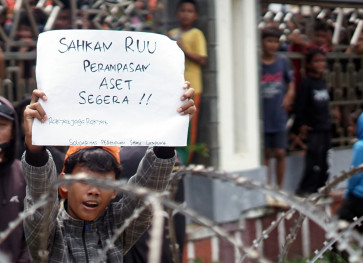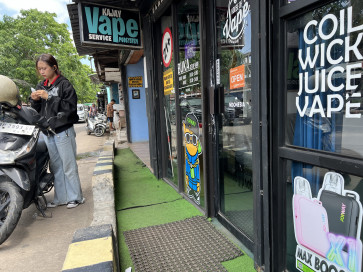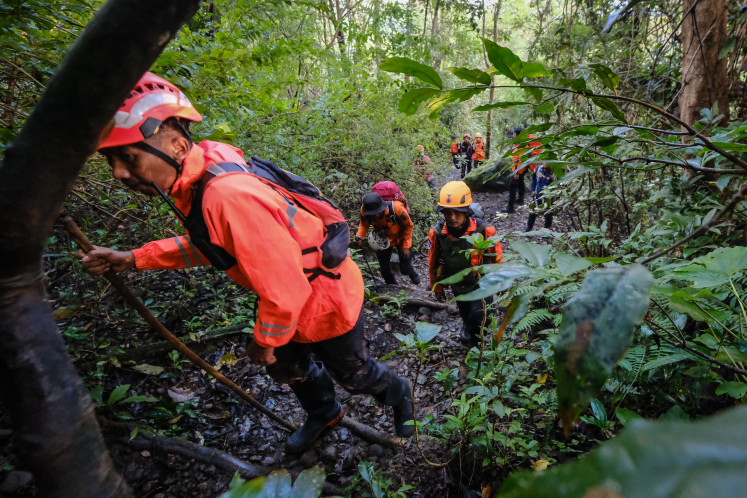Popular Reads
Top Results
Can't find what you're looking for?
View all search resultsPopular Reads
Top Results
Can't find what you're looking for?
View all search resultsSpecial Report: Suramadu bridge could last for 100 years
The Suramadu bridge in East Java, completed this month, is the longest bridge in Indonesia, connecting Java and Madura Island
Change text size
Gift Premium Articles
to Anyone
The Suramadu bridge in East Java, completed this month, is the longest bridge in Indonesia, connecting Java and Madura Island. Its construction, which cost the state Rp 4.5 trillion (US$428 million), depended on other supporting infrastructure and development in surrounding areas. The Jakarta Post's Indra Harsaputra talked recently with Suramadu bridge project head Achmad Ghofar Ismail amid preparations for its offi cial inauguration this Wednesday by President Susilo Bambang Yudhoyono prior to the presidential election in July.
Is the Suramadu bridge ready to operate after years of waiting?
From the groundbreaking ceremony up to its completion on June 10 this year, the project has taken six years. Before that, the project was carried out by my predecessors since 2002. The concept of the bridge was floated in the 1960s.
When I was appointed as the project head by the government in 2003, I predicted the bridge would be completed by Oct. 10, 2008, but due to financial constraints it was later targeted to be completed by August this year. The government again urged us to accelerate the project and eventually we managed to achieve it satisfactorily. I am currently busy working on the finishing touches and getting ready for the inauguration ceremony.
You have carried out a number of projects in Indonesia, such as the Jagorawi turnpike in 1981 and the Mahakam bridge from 1983 to 1986. Were there any differences when you were building this bridge?
I am always focused and careful in every job. I don't want something left out in every project that I do. I didn't look for a position when I carried out the Suramadu bridge project, but satisfaction and pride over the performance and the hard work of the Indonesian workers who have managed to complete a bridge that is second to none to those in other countries.
You have to know that 65 percent of the workers involved in the Suramadu bridge project were Indonesian. We also used locally-made cement that can withstand the corrosive nature of seawater, sulphide and carbon oxide. To relate the achievement, I plan to publish a book on the Suramadu bridge, as its construction process involved experts from various disciplines, such as sociologists, psychologists, religious leaders, biologists and architects.
I also plan to build a museum on the bridge collecting the entire technological equipment and important documents on the construction of the bridge. The East Java provincial administration has approved the planned construction of the museum on Madura in the hope of accelerating infrastructure development and economic growth on the island. I also hope the museum will serve as a center of sciences so that many similar bridges can be built by the younger generation in the future of Indonesia.
There are indications that the acceleration of the Suramadu bridge completion was politically motivated. Did that affect the quality of the bridge?
Despite its original completion target of August this year, I can assure you that the Suramadu bridge will reliably operate for up to the next 100 years. We are not politicians. The earlier it was completed, the better it is for the public, given the significance of the bridge in developing Madura.
To ensure that it could last for 100 years, the government should set aside Rp 30 billion annually for maintenance costs.
I also ensured that the Navy cleared the remaining 84 sea mines located around the bridge so as to ensure the safety of ships passing under the bridge. We have also prepared a regulation on the frequency of ships passing under the bridge.
Only ships below 35 meters tall will be allowed to pass. We will also impose regulations on large freighters. I hope the bridge operator will be committed to arranging shipping traffic due to its urgency.
Areas around the bridge would be subject to congestions because various facilities, such as warehouses, hotels, shopping malls and industries, would spring up around the bridge. We will continue to monitor developments so the bridge could last up to 100 years.
Are there any other options offered to prevent traffic jams at the bridge due to ship congestion?
The bridge is aimed at accelerating transportation to and from Madura and Surabaya. Earlier, it took 30 minutes to get to Madura and vice versa by ferry. But now it takes only 10 minutes. In short term, authorities only have to arrange traffic and spatial planning to prevent congestions in the Madura and Surabaya sections of the bridge.
The central government and the provincial administration should work together to create good spatial planning around the bridge. East Java Governor Soekarwo is currently developing areas around Gresik, Madura, Surabaya, Sidoarjo and Lamongan.
Spatial planning should include plans to develop the Tanjung Perak port, which has now exceeded its capacity. A number of stakeholders have also proposed the port area be focused in Teluk Lamong or the western part of Surabaya, while others have suggested development in Madura due to technical reasons.
I think Madura can very feasibly be developed as a container port given that road networks are planned in Madura. Road construction in the southern part of Java should be realized by 2010 because it could accommodate the economic potential of areas in the south of the province.
A number of areas in East Java have also planned to build ports and airports, such as Banyuwangi and Jember regencies. East Java's potential is extraordinary, but we are behind other countries only because the Tanjung Perak Port could no longer accommodate container ships.
Various development and infrastructure projects in East Java are often hampered by land acquisition and other social issues. How do you address these issues in the Suramadu project?
I have always approached residents in Madura as well as in Surabaya by explaining to them that there would always be people sacrificed in every development project, but development also yields fruits such as economic growth.
For example, fishermen once voiced their protest that the Suramadu bridge project had affected their fishing. I asked the Surabaya municipal council to provide them with new means of living in the form of permits and funds for them to engage in business, such as setting up food stalls.
Now, many of them have opened food stalls because the bridge will be crowded with people every evening and especially during holidays, where they enjoy the scenery of the bridge. I think social issues will always prevail. It depends on us to explain and seek the best solution for local residents.
The Suramadu bridge in East Java, completed this month, is the longest bridge in Indonesia, connecting Java and Madura Island. Its construction, which cost the state Rp 4.5 trillion (US$428 million), depended on other supporting infrastructure and development in surrounding areas. The Jakarta Post's Indra Harsaputra talked recently with Suramadu bridge project head Achmad Ghofar Ismail amid preparations for its official inauguration this Wednesday by President Susilo Bambang Yudhoyono prior to the presidential election in July.










